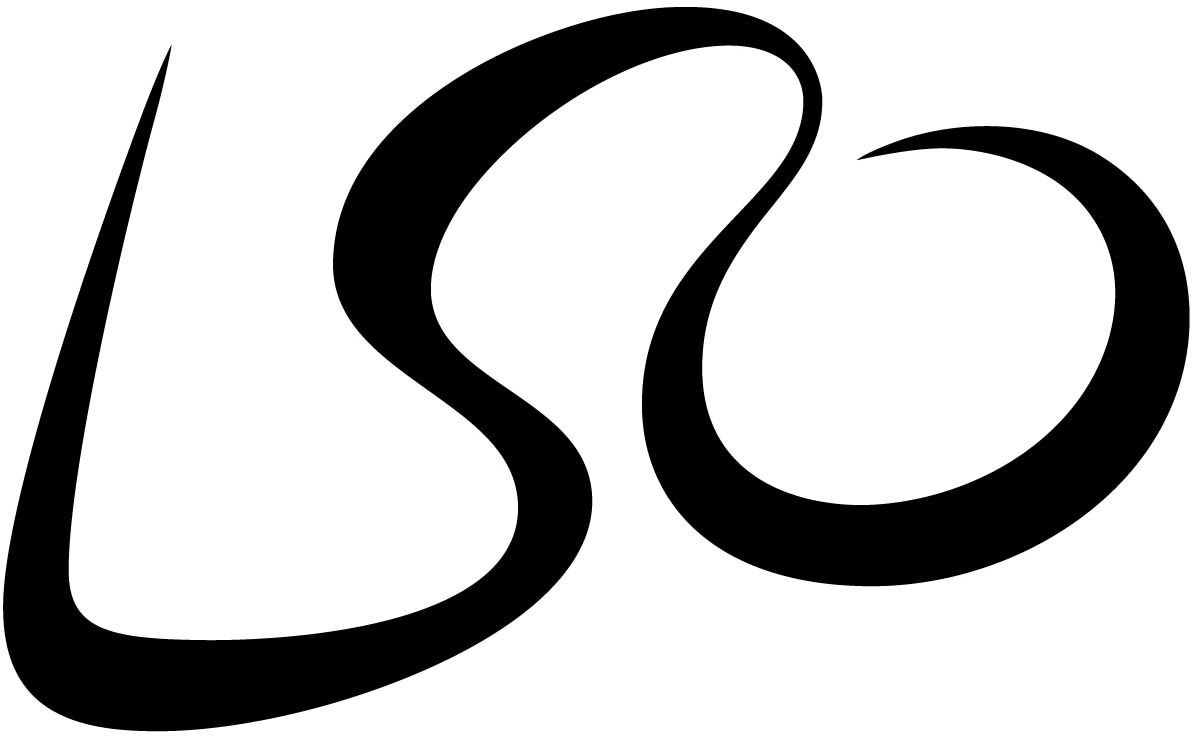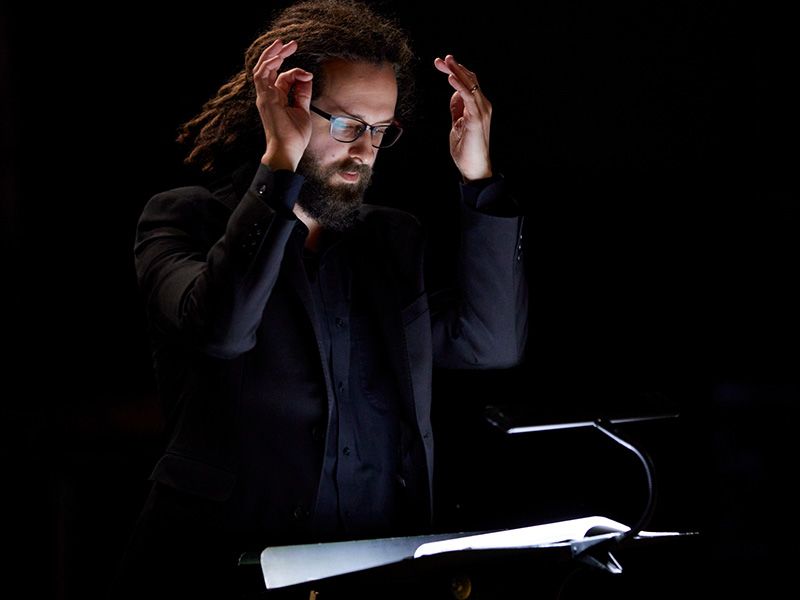London Symphony Orchestra
Soundhub Showcase

Welcome to LSO St Luke's and this Soundhub Showcase.
YOUR DIGITAL CONCERT GUIDE
You can use your phone to view this digital guide during the concert, and discover more about the music and performers.
Navigate using the menu icon (≡) at the top of the screen.

There is free WiFi available in the Jerwood Hall. Connect to the 'hawksmoor' network.
So that everyone can have the best experience, please set your phone to silent and only use it during the performance to read these notes. Photos can be taken during applause at the end of the concert.
Wednesday 15 June 7pm to 8.30pm
LSO Soundhub Showcase
Marilyn Herman 100 Full Moons of Autumn
Arthur Keegan-Bole Dorian Suite
Alex Groves Four Forms (Horizon)
Joe Bates Straight Line Through A Landscape
Colin Alexander cello
Pasha Mansurov flute
Heather Roche clarinet
Jake Brown percussion
Angela Wai-Nok Hui percussion
Lucy Knight soprano
Juliet Kelly jazz alto
Darren Bloom conductor
About the Soundhub Scheme
Based at LSO St Luke’s, LSO Soundhub provides a flexible environment where composers can explore, collaborate and experiment, with access to vital resources, support from industry professionals and LSO members and staff.
Soundhub is a composer-led resource, responding directly to the needs of those using it: a supportive framework for artists to try out new ideas, develop existing work and benefit from peer-to-peer networking and support.
LSO Soundhub is generously supported by Susie Thomson
Marilyn Herman
100 Full Moons of Autumn
✒️2022 | ⏰17 minutes

Verse 1: 100 Full Moons of Autumn
Verse 2: I can summon all the Protectors
Chorus: I dance within a blazing garland or I love you in gladness
This work, is developed from a song I wrote and sang in folk clubs in the 1990s. Its overall form corresponds to that of the original song, with each section primarily based on melodic and rhythmic material in its equivalent Verse/Chorus in the original song.
Five phrases are adapted from The Praises to the Twenty One Tara's which form part of the Tibetan Buddhist Green Tara (a manifestation of the Buddhist deity) Practice, while four 'non-deity' phrases from the original song are retained in the Chorus.
A primary feature which relates the work to its 'folk' seed is its modal character – particularly the descending Dorian mode (in combination with the Phrygian and Aeolian descending modes) on which Verse 1 is built.
Different ways of using the voice feature in this work – conventional classical, Sprechgesang, non-classical ('folk'), jazz and speech. The jazz alto has the option to choose her own scat syllables in written out 'scat-like' sections, and the Chorus contains two sections where she improvises. She makes her entry in the Chorus singing ad lib in jazz ballad style.
Glissandos and wind vibrato make a frequent appearance in Verse 2 and the Chorus, imitating note bending in jazz and folk music, and brass shakes and vocal vibrato in jazz.
Note by Marilyn Herman
Marilyn Herman
Marilyn Herman is a composer with a strong folk and jazz, as well as classical, background. Her compositions have been characterised as 'jazz-classical', and are also deeply influenced by various world musics. She has researched, published, performed and danced Ethiopian and Yemenite music. Her works have been performed at a number of venues in the UK and the United States, including five London New Winds Festivals, and a PRS workshop with John Woolrich.
Arthur Keegan-Bole
Suite for Dorian
✒️2022 | ⏰14 minutes

I Portrait & Pact
II Transformation 1
III Transformation 2
IV Scene (confrontation & finale)
This suite develops musical material for a prospective ballet for solo dancer based on Oscar Wilde's tale of Dorian Gray. The idea for the stage work is to re-imagine the portrait as a video installation, which opens the possibility of a dancer (Dorian) duetting in real time with a portrait of themselves.
The dance will be structured in four narrative scenes (duets for solo dancer with video) with ‘transformation’ interludes for video and music only which depict the corruption of the portrait. This suite consists of four movements, the first and fourth develop material intended for the narrative scenes and the second and third develop material intended for the ‘transformation’ interludes.
The first movement is a brief statement for all instruments that transforms slow music with distinct instrumental parts to a faster passage integrating all of the ensemble.
The second movement is led by the flute, with ensemble and electronic extensions of the flute sound. These ‘extensions’ grow and extend, eventually subsuming the flute.
The third movement is initially led by the clarinet which gives way to a reprise of the opening material and a fairly long passage for cello and electronics in which the cello is extended and expanded by live transposition, transforming and enlarging the instrumental sound.
The final movement features a mix of quicker material for cello alongside stately chords and textures that eventually win out toward a stark ending (as the portrait comes to dominate Dorian).
The video presented here is very much a demo to help contextualise e the visual element. The long-term intention is something more deeply integrated with the music (and certainly not my own face!).
I have been thinking about the idea for this piece for about seven years, so I am delighted to have had the chance to develop this music (huge thank you to LSO Soundhub scheme and the fabulous players and technicians for making this possible!). With this musical material I can approach choreographers, videographers and funders in order to take the project to the next stage. I’d also like to thank Sally Beamish who has patiently supported me in this project as mentor. Her enquiries, insights and suggestions have been extremely helpful, and her enthusiasm is infectious and encouraging.
Note by Arthur Keegan -Bole
Arthur Keegan-Bole
Arthur Keegan-Bole is a composer whose music is often inspired by text; from poetry and literature to twitter feeds and graffiti. Current projects include a collaboration with mezzo-soprano Lotte Betts-Dean exploring poetry by Thomas Hardy. This includes a new song cycle for guitar and voice, a full-scale string quartet with mezzo-soprano as well as a suite of arrangements of songs that set Hardy from the last 100 years.
Arthur says 'I am surprised (and delighted!) to be making a composing career at all'. Having grown up in a non-musical, working class household, he began to learn the guitar aged 14. 'A friend took me to my first classical music concert when I was 16 and from that point on, I began an intense journey toward composing professionally.'
Arthur's music has been broadcast on BBC Radio 3 and performed across the UK, as well as in the US and Canada. He is a recipient of the Paul Hamlyn Award for Artists 2020.
Alex Groves
Four Forms (Horizon)
✒️2022 | ⏰15 minutes

Four Forms (Horizon) is a sonic sculpture garden of interwoven lines and ever-changing vistas. Each performer acts as an independent entity – their music always slightly apart from one another, although sharing similar DNA. Throughout the piece, these distinct elements are viewed in a number of ways as if the sight lines are constantly shifting and your focus is being drawn from one to the other. The material builds from the start, layering sounds in the electronics until the piece seems to break down under its own weight. As the piece comes apart, the electronics take centre stage creating an intricate, fractured sound world that slowly dissipates.
Note by Alex Groves
Alex Groves
© Sam Le Roux
© Sam Le Roux
Alex Groves is an Ivor Novello-nominated composer and curator working across contemporary classical and electronic music. His work blends classical instruments, ambient textures and live-processed electronics to create uncanny soundworlds which blur the line between acoustic and electronic.
Current projects include commissions for soloists Kate Ellis, Zubin Kanga and Benjamin Goldscheider, collaborations with the National Gallery and MONOM, and performances with EXAUDI and Plus Minus Ensemble. Other recent work includes commissions for Rakhi Singh, Manchester Collective and London Contemporary Dance School, and a new music theatre work for English Touring Opera.
His music has been presented at the Southbank Centre, Barbican Centre, Sage Gateshead, Royal Opera House, V&A, Union Chapel, St George's Bristol and King's Place, broadcast on NTS Radio, BBC Radio 3 and BBC Radio 6 Music, and released on Nonclassical and Bedroom Community.
Joe Bates
Straight Line Through A Landscape
✒️2022 | ⏰16 minutes

In the ‘straight line mission,’ YouTuber Thomas George Davies attempts to cross a country in a straight line. Guided by GPS, he follows his pre-planned route, no matter the hedgerows, rivers, or angry farmers that bar his way. Beyond their entertainment value, these videos reveal much about a modern landscape: how nature collides with digital logic, how laws and customs rebuff an abstract line on a map.
This reminded me of tuning theory, which is full of numbers representing frequency ratios. As a good theorist, you make the numbers dance, creating wonderful chords arrayed on a page. But these are refigured by reality: our instruments, our ears, and our muscle memories have their own ideas about which tunings have significance, and which are merely inflections.
In this piece, the glissandos act as straight lines through a tuned landscape. It was important that this line be inevitable and self-willed, but an electronic sonority felt wrong. Instead, we witness the inevitability of a physical process: siphons connect four glass vessels, retuning them as they move. To me, it is ceremonial, a procession through pitch space in which four musicians animate the machinery of gravity, water, and glass.
Note by Joe Bates
Joe Bates
© Ilme Vysniauskaite
© Ilme Vysniauskaite
Joe Bates’ music combines hazy, drifting melodies with dancing, looping chords to create a detached but intense sound world. He creates new tunings and tonalities, organised by the familiar rhetorics of classical harmony and electronic dance music. To writer Tim Rutherford-Johnson, this evokes ‘the court music of a short-lived empire’.
Joe’s first musical love was for the orchestral classics of the 20th century; he spent his teenage years aping Béla Bartók. At university, he became involved in drag and pop, and founded a mixed-genre music night, Filthy Lucre. Recently, he has been researching novel tuning systems, trying to think how one might make strange chords sound like home.
His music is born in the collision of these influences, embracing orchestral music, vocal music, and synth-heavy electronics. He writes for himself, as a solo electronic performer, and for others, using classical notation. His music is inspired by composers from Kaija Saariaho to Giacinto Scelsi, songwriters like Fiona Apple and D’Angelo, writers like Ursula Le Guin and Derek Parfait, and artists like Hilma Af Klint and Abu Al-Hasan.
Artist Biographies

Darren Bloom
conductor
Darren Bloom is a composer, conductor, producer and educator. He is a founding member and conductor/creative producer of the Ossian Ensemble with whom he has given the premieres of dozens of new works over the past decade. Other conducting highlights include a performance of Sir Peter Maxwell Davies’ Five Klee Pictures in the presence of the composer, recording music for BBC4 documentaries, directing several youth new music ensembles, including the Composers Ensemble at Junior Trinity, and working for the past four years as a conductor for the LSO Soundhub scheme.
Darren studied composition with Edwin Roxburgh, Brian Elias and Sir Peter Maxwell Davies, and conducting with Neil Thompson, Edwin Roxburgh and Christopher Austin. He was awarded a DipRAM and the Manson Fellowship from the Royal Academy of Music as well as recently being appointed an Associate of the RAM. In 2015 he commenced an AHRC funded PhD in Composition at the University of Cambridge under the supervision of Richard Causton.
Darren is an alumnus of the LSO Soundhub Scheme. His piece Dr Glaser's Experiment was premiered at LSO St Luke's in March 2016 as part of the LSO Futures festival.
On Stage

Colin Alexander cello
Pasha Mansurov flute
Heather Roche clarinet
Jake Brown percussion
Angela Wai-Nok Hui percussion
Lucy Knight soprano
Juliet Kelly jazz alto
Darren Bloom conductor
Thank You for Listening
The London Symphony Orchestra was established in 1904. Through inspiring music, educational programmes and technological innovations, the LSO’s reach extends far beyond the concert hall.
Visit our website to find out more.

TELL US WHAT YOU THOUGHT
We hope you enjoyed tonight's concert, and would love to hear about your experience. Let us know your thoughts by filling out a short survey.
Dates for Your Diary
Friday Lunchtime Concert: LSO String Quartet
Friday 1 July 12.30pm, LSO St Luke's
Make the most of your lunchbreak and enjoy a free, 45-minute informal concert at LSO St Luke’s. This concert features the world premiere of Movements for Piano and Strings by Daniel Kidane, who has been involved in the LSO's three schemes for composers.
New Music Britain
Sunday 11 September 7pm, Barbican
Sir Simon Rattle kicks off the new LSO season with the best of British – from the sweeping landscapes of Elgar and Frank Bridge to the 21st-century sounds of Daniel Kidane.






